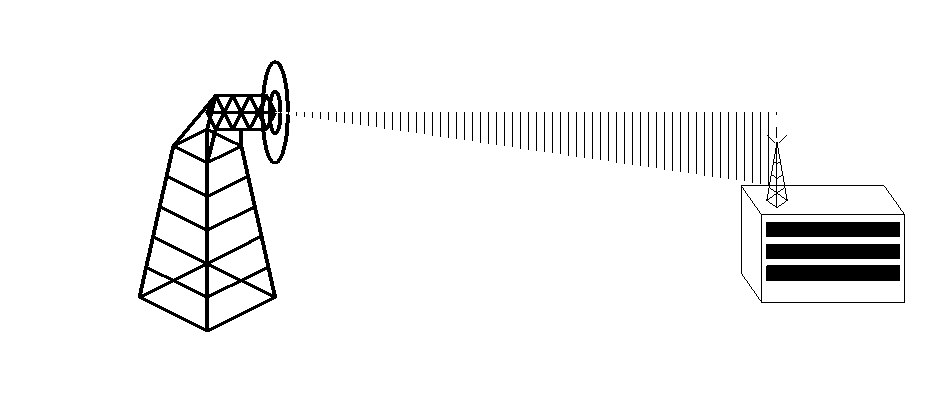
|

|
|
|

|

|

Wireless installation Line-Of-Sight (LOS) by Assess-Design-Deploy, A-D-D.
 Assess
Free Space Loss (FSL) – measured in dB, how much signal has weakened over a given distance. The difference in FSL between a 2.4 GHz link and a 5.8 GHz link is always about 8 dB, regardless of the distance.
Fresenal zone – the area that the signal spreads out into, any obstacles in the zone, part of the signal will be diffracted from the straight-line path. The higher the frequency, the smaller the zone. Verify not only clear line of sight but also at least 60% of the first part of the Fresenal zone.
Antenna – isotropic (no gain) radiator, measured in dBi.
Effective isotropic radiated power (EIRP) is the actual RF power as measured in the main lobe (or focal point) of an antenna. It is equal to the sum of the transmit power into the antenna (in dBm) added to the dBi gain of the antenna. E.g. +24 dBm of power (250 mW) into a 24 dBi gain antenna, gives EIRP equal to 48 dBm (64 Watts).
Multipath Interferance – reflected signals arrive at a receiving antenna add and subtract from the main signal.
Signal-to-noise ration (SNR) – ratio of signal between level received and noise (larger positive number or small negative number is better SNR)
Receiver Sensitivity – signal needed for good reception.
System Operating Margin (SOM) – difference between the signal level received and the signal needed for good reception. SOM = RX signal (dBm) – RX sensitivity (dBm) i.e., what you are getting minus what you need. A SOM of greater than 20 dB is likely to provide stable communications. The SOM value may be strong but if there is a lot of multipath interference, etc. degrading the SNR you will not have stable communications.
Design
FSL = 36.6 + 20logF + 20logD
F = freq. in MHz, D = distance in miles
e.g. 2.4 GHz, 36.6 + 20logF = 104.2dB and at 5.8 GHz = 111.8dB
Where 2.4 GHz FSL: 110 dB at 2 mi.; 116 dB at 4 mi.; 119 dB at 6 mi.; 124 dB at 10 mi.; 130 dB at 20 mi.
Where 5.8 GHz FSL: 118 dB at 2 mi.; 124 dB at 4 mi.; 127 dB at 6 mi.; 132 dB at 10 mi.; 138 dB at 20 mi.
Rule of thumb: double/halve the distance, then add/subtract 6 dB
Deploy
EIRP = TX Power – Cable Loss + TX Antenna Gain
RX Signal = EIRP – FSL + RX Antenna Gain – Cable Loss
Assess
Free Space Loss (FSL) – measured in dB, how much signal has weakened over a given distance. The difference in FSL between a 2.4 GHz link and a 5.8 GHz link is always about 8 dB, regardless of the distance.
Fresenal zone – the area that the signal spreads out into, any obstacles in the zone, part of the signal will be diffracted from the straight-line path. The higher the frequency, the smaller the zone. Verify not only clear line of sight but also at least 60% of the first part of the Fresenal zone.
Antenna – isotropic (no gain) radiator, measured in dBi.
Effective isotropic radiated power (EIRP) is the actual RF power as measured in the main lobe (or focal point) of an antenna. It is equal to the sum of the transmit power into the antenna (in dBm) added to the dBi gain of the antenna. E.g. +24 dBm of power (250 mW) into a 24 dBi gain antenna, gives EIRP equal to 48 dBm (64 Watts).
Multipath Interferance – reflected signals arrive at a receiving antenna add and subtract from the main signal.
Signal-to-noise ration (SNR) – ratio of signal between level received and noise (larger positive number or small negative number is better SNR)
Receiver Sensitivity – signal needed for good reception.
System Operating Margin (SOM) – difference between the signal level received and the signal needed for good reception. SOM = RX signal (dBm) – RX sensitivity (dBm) i.e., what you are getting minus what you need. A SOM of greater than 20 dB is likely to provide stable communications. The SOM value may be strong but if there is a lot of multipath interference, etc. degrading the SNR you will not have stable communications.
Design
FSL = 36.6 + 20logF + 20logD
F = freq. in MHz, D = distance in miles
e.g. 2.4 GHz, 36.6 + 20logF = 104.2dB and at 5.8 GHz = 111.8dB
Where 2.4 GHz FSL: 110 dB at 2 mi.; 116 dB at 4 mi.; 119 dB at 6 mi.; 124 dB at 10 mi.; 130 dB at 20 mi.
Where 5.8 GHz FSL: 118 dB at 2 mi.; 124 dB at 4 mi.; 127 dB at 6 mi.; 132 dB at 10 mi.; 138 dB at 20 mi.
Rule of thumb: double/halve the distance, then add/subtract 6 dB
Deploy
EIRP = TX Power – Cable Loss + TX Antenna Gain
RX Signal = EIRP – FSL + RX Antenna Gain – Cable Loss
|

|
|
